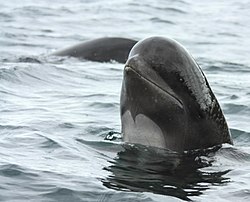| Globicephalinae | |
|---|---|
 | |
| Pilot whale spyhopping | |
| Scientific classification | |
| Kingdom: | Animalia |
| Phylum: | Chordata |
| Class: | Mammalia |
| Order: | Artiodactyla |
| Infraorder: | Cetacea |
| Family: | Delphinidae |
| Subfamily: | Globicephalinae Le Duc, 1997 |
Globicephalinae is a subfamily of oceanic dolphins that includes the pilot whales (Globicephala spp.), the pygmy killer whale (Feresa attenuata), the rough-toothed dolphin (Steno bredanensis), the false killer whale (Pseudorca crassidens), the melon-headed whale (Peponocephala electra), Risso's dolphin (Grampus griseus), and the snubfin dolphins ( Orcaella spp.). [1] [2]
| Delphinidae | |||||||||
| |||||||||
| Relations within Globicephalinae [1] |